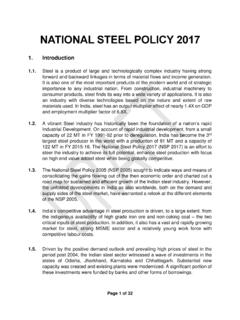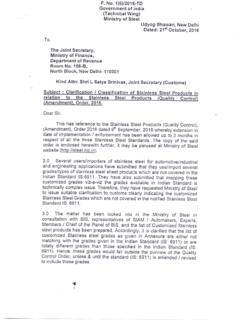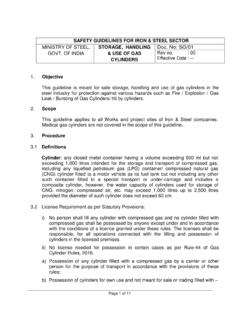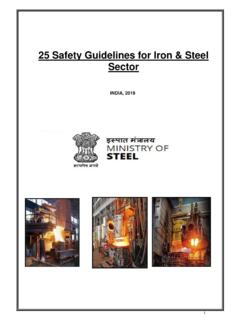Transcription of Steel Scrap Recycling Policy - Ministry of Steel
1 GOVERNMENT OF INDIA Ministry OF Steel 1 Steel Scrap Recycling Policy GOVERNMENT OF INDIA Ministry OF Steel 2 PREAMBLE Ministry of Steel s endeavor is to develop a globally competitive Steel industry by adopting state of the art environment friendly technologies.
2 Ferrous Scrap being the primary raw material for EAF/ IF based Steel production, the Policy envisages a framework to facilitate and promote establishment of metal scrapping centers in India. This will ensure scientific processing & Recycling of ferrous Scrap generated from various sources and a variety of products. The Policy framework shall provide standard guidelines for collection, dismantling and shredding activities in an organized, safe and environmentally sound manner GOVERNMENT OF INDIA Ministry OF Steel 3 CONTENTS 1.
3 INTRODUCTION .. 4 2, OBJECTIVES .. 10 3. WORKING MODEL .. 10 4. GUIDELINES .. 12 5. POINTS FOR AUTHORIZATION/DE-AUTHORIZATION .. 14 6. EVOLVING A RESPONSIVE ECOSYSTEM .. 16 ROLES OF AGGREGATORS .. 16 RESPONSIBILITIES OF DISMANTLING & Scrap PROCESSING CENTERS (SCS) .. 17 GOVERNMENT S RESPONSIBILITY .. 19 MANUFACTURER S RESPONSIBILITY .. 22 OWNER S RESPONSIBILITY .. 24 8. POWER TO AMEND THE Policy .. 26 9. CONCLUSION .. 26 10 DEFINITIONS .. 26 AGGREGATORS / COLLECTION CENTRES .. 26 AUTHORITY .. 26 CERTIFICATE OF DESTRUCTION (COD) .. 27 COLLECTION ACTIVITY .. 27 COLLECTION CUM DISMANTLING CENTERS/ DISMANTLING CENTRE.
4 27 DISMANTLING ACTIVITY .. 27 END OF LIFE VEHICLES (ELVS).. 27 OTHER SCRAPS .. 28 OWNER .. 28 PROCESSING CENTERS (PCS) / FACILITY .. 29 Scrap PROCESSING ACTIVITY .. 29 WHITE GOODS .. 29 ANNEXURE-I 30 Acknowledgement 31 GOVERNMENT OF INDIA Ministry OF Steel 4 1. Introduction Steel is a material most conducive for circular economy as it can be used, reused and recycled infinitely.
5 While iron ore remains the primary source of Steel making, used or re-used Steel in the form of Scrap is the secondary raw material for the Steel industry. Indian Steel industry is characterized by the presence of a large number of small Steel producers who utilize Scrap with other inputs in EAF/IF for Steel making. As on March 2019, 47 Electric Arc Furnaces & 1128 Induction Furnaces are operating in the country and largely depend upon Scrap as a raw material to produce Steel . National Steel Policy 2017 (NSP-2017) aims to develop a globally competitive Steel industry by creating 300 Million TPA Steel production capacity by 2030 with a contribution of 35-40% from EAF/IF route.
6 Although, Scrap is the main raw material for secondary sector but primary sector also uses Scrap in the charge mix of BOF to the tune of 15% to improve efficiency, minimize cost of production and other process needs. The availability of raw materials at competitive rates is imperative for the growth of the Steel industry and to achieve NSP-2017 target. Thus, the availability of right quality of Scrap , in adequate quantity is one of the critical factors for the future growth for both EAF/IF sector & primary sector. Further, Scrap based Steel making technologies have been envisaged as one of the important options to reduce GHG emission intensity.
7 This shall feature as an important initiative of the Steel sector to minimize Green House Gas (GHG) emissions. This shall also contribute in adopting the principle of 6Rs Reduce, GOVERNMENT OF INDIA Ministry OF Steel 5 Reuse, Recycle, Recover, Redesign and Remanufacture to avoid any adverse impact on the environment and strengthening the foundation of sustainable development.
8 In the NSP-2017 the importance of Scrap was realised. This Scrap Policy only furthers the role envisaged in the NSP-2017 to ensure Scrap segregation (quality wise), collection, processing and Recycling . The Policy is to provide a framework for carrying out the activities in a scientific manner to have assured and regular supply of processed Scrap for the downstream industry. Steel Scrap comes from various sources such as mill Scrap , used structural items like beams, reinforced Steel & plates, plant and machineries including pipes, tubes, old vehicles, domestic goods, automotive scraps, ship building industry, railways etc.
9 The present Policy deals with automobile, house hold, structural, railways, industrial etc. but exclude specific industries like ship breaking which are covered under separate act / Policy . There is a worldwide trend to increase Steel production using Scrap as the main raw material as Recycling of Scrap helps in conservation of vital natural resources besides other numerous benefits. The use of every ton of Scrap shall save ton of iron ore, 630 kg of coking coal and 55 kg of limestone. There shall be considerable saving in specific energy consumption also as the same will reduce from around 14 MJ/Kg in BF/BOF route to less than 11 MJ/ Kg in EAF/IF route, savings in energy by 16-17%.
10 It also reduces the water consumption and GHG emission by 40% and 58% respectively. Thus, the demand of Steel Scrap has increased considerably in the past globally from 367 mt in 2000 to 589 mt in 2017 as can be seen from figure-1 GOVERNMENT OF INDIA Ministry OF Steel 6 Fig-1: Global Steel Production and Scrap Consumption1 Most of the major Steel producing countries like Japan, USA, and China are continuously increasing Scrap -based Steel production with proportionate reduction from primary route.









